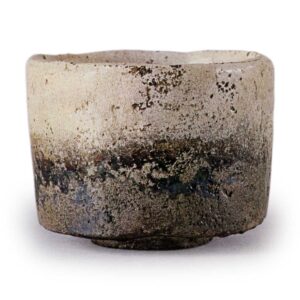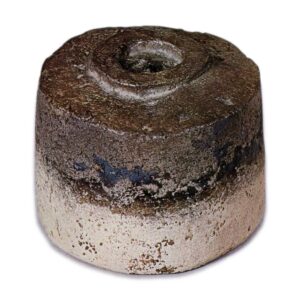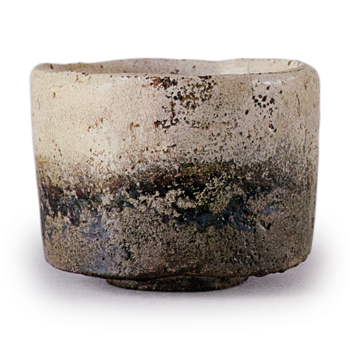

National Treasure
Height 8.5cm, Bowl diameter 11.6cm, Stand diameter 5.4cm
On the cover of the inner box, Hon’ami Koetsu himself wrote “Fujisan Daikyobanzu”, and this is the only Koetsu tea bowl in the world that can be said to be a Koetsu kyobako. This is the only Koetsu tea bowl that can be said to be a Koetsu kyobako among the Koetsu tea bowls of the past. It is called the first masterpiece among the Koetsu tea bowls, and is said to be the most dignified tea bowl among the tea bowls produced since the Momoyama period. The inscription “Fujiyama” is thought to have been written by Koetsu himself, as the white-glazed tea bowl, with the under half of the glazed surface burnt and turned grayish-black, reminded him of the white snow-capped mountains of Fuji, and the unexpected scene that occurred in the kiln, as no two scenes are alike.
It is a semi-tubular tea bowl with a ridge tightly set at the waist, rising up from the waist to the mouth, with a flat and clear ring-shaped stand with tatami mats, and lifting up in a low straight line from the stand to the waist. This shape is one of the representative forms of Koetsu tea bowls, and is common to “Shichisato”, “Kaga Koetsu”, and “Koetsu Kuro”, etc. It is also a unique shape that was not found in the hand-sewn tea bowls before Koetsu, such as Chojiro ware.
The body is painstakingly and finely chiseled, and the center of the bowl is slightly deeply chiseled and almost flattened, and the gentle curvature of the surface is unique to Koetsu.
The most remarkable feature of this tea bowl in terms of form is the superb workmanship of the height and the area from the edge of the height to the waist, and the cutting inside the height also shows the unique technique of Koetsu. It seems to have been fired with white glaze over the entire surface, but the glazed surface changed to blackish brown both inside and outside in the kiln, creating an unexpected scene. Some of the burnt surface has a leaden color, and some of the glaze has peeled off to reveal white glaze.
It is said that Koetsu’s daughter brought this bowl to her wedding home, and it is said that it was also called “Furisode Chawan” (Furisode Tea Bowl) because it comes with a small piece of leftover fabric from her daughter’s furisode (long-sleeved kimono), which has a stitched pattern on it. The origin of this bowl is not known, but it came into the possession of Hikita Gonpei during the Tempo period, and later became the property of Sakai Garakuto Chugaku, Marquis of Himeji, and was handed down to his family.



